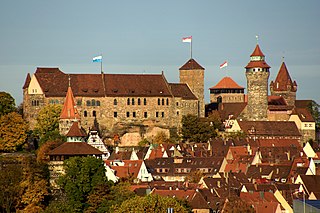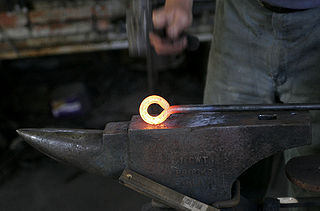Related Research Articles

Nuremberg is the largest city in Franconia, the second-largest city in the German state of Bavaria, and its 544,414 (2023) inhabitants make it the 14th-largest city in Germany.
Van Eyck or Van Eijk is a Dutch toponymic surname. Eijck, Eyck, Eyk and Eijk are all archaic spellings of modern Dutch eik ("oak") and the surname literally translates as "from/of oak". However, in most cases, the family name refers to an origin in Maaseik. This city on the Meuse, now in Belgium on the border with the Netherlands, was originally simply known as Eike and from the 13th century as Old Eyck and New Eyck. Names with an affix (tussenvoegsel), like Van der Eijk, are more likely to refer directly to the tree. This article lists people with this surname.

The Nuremberg Chronicle is an illustrated encyclopedia consisting of world historical accounts, as well as accounts told through biblical paraphrase. Subjects include human history in relation to the Bible, illustrated mythological creatures, and the histories of important Christian and secular cities from antiquity. Finished in 1493, it was originally written in Latin by Hartmann Schedel, and a German version was translated by Georg Alt. It is one of the best-documented early printed books—an incunabulum—and one of the first to successfully integrate illustrations and text.
The term von ( ) is used in German surnames either as a nobiliary particle indicating a noble patrilineality, or as a simple preposition used by commoners that means 'of' or 'from'.

Smith is an occupational surname originating in England. It is the most prevalent surname in the United Kingdom, the United States, Australia, Canada, and New Zealand, and the fifth most common surname in the Republic of Ireland. In the United States, the surname Smith is particularly prevalent among those of English, Scottish, and Irish descent, but is also a common surname among African-Americans, which can be attributed either to African slaves having been given the surname of their masters, or to being an occupational name, as some southern African-Americans took this surname to reflect their or their father's trade. 2,442,977 Americans shared the surname Smith at the time of the 2010 census, and more than 500,000 people shared it in the United Kingdom as of 2006. At the turn of the 20th century, the surname was sufficiently prevalent in England to have prompted the statement: "Common to every village in England, north, south, east, and west"; and sufficiently common on the (European) continent to be "common in most countries of Europe".

Michael Wolgemut was a German painter and printmaker, who ran a workshop in Nuremberg. He is best known as having taught the young Albrecht Dürer.
Micallef is a Maltese surname. It has been recorded in Malta since ancient times, and its origins probably lie in the name Micali, a variant of Michael. However, another possible derivation for the surname is the Maltese word "mħallef", which means 'judge', and thus its origin is not certain. This surname is found in various Medieval records, normally as Makluffi. Prior to the late 15th century, most people bearing this surname were of the Jewish faith.
Gargiulo is an Italian surname from Southern Italy, primarily Naples, but also common in South America, especially Argentina. A small number of Gargiulo's change the spelling to Corjulo when they immigrated to the United States.
The surnames Scharf, Schärf, Schaerff, Sharf, as well as similar spellings of these names, usually have their origins in either the German or Irish languages. As a result of emigration from Europe, these surnames are now also common throughout the United States, Canada and Australia.

The Triumphal Arch is a 16th-century monumental woodcut print commissioned by the Holy Roman Emperor Maximilian I. The composite image was printed on 36 large sheets of paper from 195 separate wood blocks. At 295 × 357 centimetres, it is one of the largest prints ever produced and was intended to be pasted to walls in city halls or the palaces of princes. It is a part of a series of three huge prints created for Maximilian, the others being a Triumphal Procession which is led by a Large Triumphal Carriage ; only the Arch was completed in Maximilian's lifetime and distributed as propaganda, as he intended. Together, this series has been described by art historian Hyatt Mayor as "Maximilian's program of paper grandeur". They stand alongside two published biographical allegories in verse, the Theuerdank and Weisskunig, heavily illustrated with woodcuts.
Calleja is a surname found in Spain and Malta. It is unclear whether the Maltese and Spanish surnames are related or a coincidence, perhaps caused by romanization.
Belsky is a Russian surname. When transliterated as Bielski it can also refer to a Polish family of the same name.
Verhagen is a Dutch-language toponymic surname. It is a contraction of Van der Hagen, meaning "from/of the haag. A haag was a bushland, hedged lot, or (private) hunting ground. The name could also specifically refer to an origin in The Hague. Some variant spellings of the name are Verhaagen, Verhaegen, Verhaeghe, Verhaeghen, Verhage, and Verhaghen. People with the name include:
AnimalBase is a project brought to life in 2004 and is maintained by the University of Göttingen, Germany. The goal of the AnimalBase project is to digitize early zoological literature, provide copyright-free open access to zoological works, and provide manually verified lists of names of zoological genera and species as a free resource for the public. AnimalBase contributed to opening up the classical taxonomic literature, which is considered as useful because access to early literature can be difficult for researchers who need the old sources for their taxonomic research.

Saint Michael Fighting the Dragon is a woodcut of 1498 by Albrecht Dürer, part of his Apocalypse series, illustrating the Book of Apocalypse or Revelation of St. John.
The anglicisation of personal names is the change of non-English-language personal names to spellings nearer English sounds, or substitution of equivalent or similar English personal names in the place of non-English personal names.
In Sweden, a person must have a surname and one or more given names. Two given names are common. Surnames are inherited from the parents, in the order of "same as elder sibling, if any; specified by parents; or mother's last name," while given names must be chosen by the parents at birth. The calling name by which the person is normally identified in conversation, is in Scandinavian countries one of the given names, not necessarily the first. In contexts where the full name is spelled out, the calling name is often indicated by an asterisk, by capital letters, or underlines or italics. For example, Märta Birgit* Nilsson is known as Birgit Nilsson, while Björn* Kristian Ulvaeus is known as Björn Ulvaeus.
Bok is a surname of several origins.
Bauernfeind is a German surname. It originates as a byname, literally "peasants' enemy", in the late medieval period, before that a comparable Geburenhasz is on record. The form Geburnvint is found in the poem Der Renner as a generic byname of "villains". Historical spelling variants include Pawrnfeynt, Pawrveint, Gebure vient. Specific individuals with the byname are on record in the 15th century. Later, the byname was generically applied to men-at-arms or Landsknechte who chastised the peasant population in the service of a feudal lord. The name gradually developed into a surname in the course of the 16th century. As of 2013 the name had 748 entries in the German telephone directory, with the greatest concentration in Bavaria, and 398 entries for the variant Bauerfeind, with a concentration in North Rhine-Westphalia.

Sebastian Schedel (1570–1628) was a German painter and illustrator best known for his contributions to the Hortus Eystettensis. A few of the original drawings for the Hortus Eystettensis are preserved at Kew in a codex called Schedel’s Calendarium.
References
- ↑ Chriftoph Gottlieb von Murr, Neues Journal zur Litteratur und Kunstgeschichte, Neues Journal, 1787.
- ↑ My Heritage verwandt.de